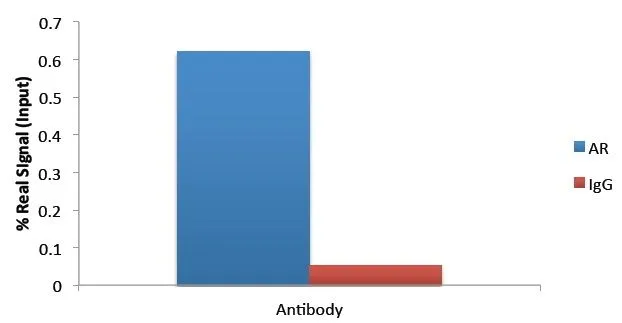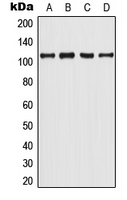![IHC-P analysis of human prostate tissue using GTX22742 Androgen Receptor antibody [AN1-15]. A : isotype control B : Primary antibody C : Primary antibody with magnified section Antigen retrieval : HEIR with a buffer (pH 6.2) Dilution : 2 microg/ml IHC-P analysis of human prostate tissue using GTX22742 Androgen Receptor antibody [AN1-15]. A : isotype control B : Primary antibody C : Primary antibody with magnified section Antigen retrieval : HEIR with a buffer (pH 6.2) Dilution : 2 microg/ml](https://www.genetex.com/upload/website/prouct_img/normal/GTX22742/GTX22742_1090_IHC-P_w_23060620_939.webp)
IHC-P analysis of human prostate tissue using GTX22742 Androgen Receptor antibody [AN1-15]. A : isotype control B : Primary antibody C : Primary antibody with magnified section Antigen retrieval : HEIR with a buffer (pH 6.2) Dilution : 2 microg/ml
Androgen Receptor antibody [AN1-15]
GTX22742
ApplicationsGel Shift Assay, ImmunoFluorescence, ImmunoPrecipitation, Western Blot, ImmunoCytoChemistry, ImmunoHistoChemistry, ImmunoHistoChemistry Frozen, ImmunoHistoChemistry Paraffin
Product group Antibodies
TargetAR
Overview
- SupplierGeneTex
- Product NameAndrogen Receptor antibody [AN1-15]
- Delivery Days Customer9
- Application Supplier NoteWB: 1:50-1:500. ICC/IF: 5 microg/ml. IHC-P: 2-4 microg/mL. IHC-Fr: 2-4 microg/mL. *Optimal dilutions/concentrations should be determined by the researcher.Not tested in other applications.
- ApplicationsGel Shift Assay, ImmunoFluorescence, ImmunoPrecipitation, Western Blot, ImmunoCytoChemistry, ImmunoHistoChemistry, ImmunoHistoChemistry Frozen, ImmunoHistoChemistry Paraffin
- CertificationResearch Use Only
- ClonalityMonoclonal
- Clone IDAN1-15
- ConjugateUnconjugated
- Gene ID367
- Target nameAR
- Target descriptionandrogen receptor
- Target synonymsAIS, AR8, DHTR, HUMARA, HYSP1, KD, NR3C4, SBMA, SMAX1, TFM, androgen receptor, dihydrotestosterone receptor, nuclear receptor subfamily 3 group C member 4
- HostRat
- IsotypeIgG
- Protein IDP10275
- Protein NameAndrogen receptor
- Scientific DescriptionThe androgen receptor gene is more than 90 kb long and codes for a protein that has 3 major functional domains: the N-terminal domain, DNA-binding domain, and androgen-binding domain. The protein functions as a steroid-hormone activated transcription factor. Upon binding the hormone ligand, the receptor dissociates from accessory proteins, translocates into the nucleus, dimerizes, and then stimulates transcription of androgen responsive genes. This gene contains 2 polymorphic trinucleotide repeat segments that encode polyglutamine and polyglycine tracts in the N-terminal transactivation domain of its protein. Expansion of the polyglutamine tract from the normal 9-34 repeats to the pathogenic 38-62 repeats causes spinal bulbar muscular atrophy (SBMA, also known as Kennedys disease). Mutations in this gene are also associated with complete androgen insensitivity (CAIS). Alternative splicing results in multiple transcript variants encoding different isoforms. [provided by RefSeq, Jan 2017]
- Storage Instruction-20°C or -80°C,2°C to 8°C
- UNSPSC12352203
References
- LSD1/PRMT6-targeting gene therapy to attenuate androgen receptor toxic gain-of-function ameliorates spinobulbar muscular atrophy phenotypes in flies and mice.Read this paper
- Inhibition of chronic prostate inflammation by hyaluronic acid through an immortalized human prostate stromal cell line model. Liu MC et al., 2017, PLoS OneRead this paper

![WB analysis of 25 ug of T47D (lane 1), LNCaP (lane 2) and NIH-3T3 (lane 3) lysates using GTX22742 Androgen Receptor antibody [AN1-15]. Dilution : 1:100 WB analysis of 25 ug of T47D (lane 1), LNCaP (lane 2) and NIH-3T3 (lane 3) lysates using GTX22742 Androgen Receptor antibody [AN1-15]. Dilution : 1:100](https://www.genetex.com/upload/website/prouct_img/normal/GTX22742/GTX22742_1579_WB_w_23060620_663.webp)
![IHC-P analysis of primate brain tissue using GTX22742 Androgen Receptor antibody [AN1-15]. IHC-P analysis of primate brain tissue using GTX22742 Androgen Receptor antibody [AN1-15].](https://www.genetex.com/upload/website/prouct_img/normal/GTX22742/GTX22742_2038_IHC-P_w_23060620_641.webp)
![WB analysis of (1) BSA, (2) recombinant protein AR and (3) protein marker using Androgen Receptor antibody [3C6-F12-F11] at a concentration of 0.5 microg/ml.](https://www.genetex.com/upload/website/prouct_img/normal/GTX16032/GTX16032_WB_w_23060620_869.webp)

![IHC-P analysis of human prostate carcinoma tissue using GTX29474 Androgen Receptor antibody [AR 441].](https://www.genetex.com/upload/website/prouct_img/normal/GTX29474/GTX29474_20191203_IHC-P_132_w_23060722_648.webp)

